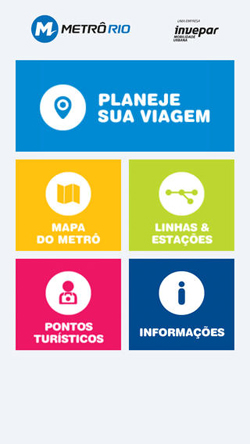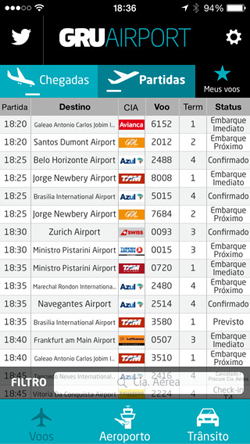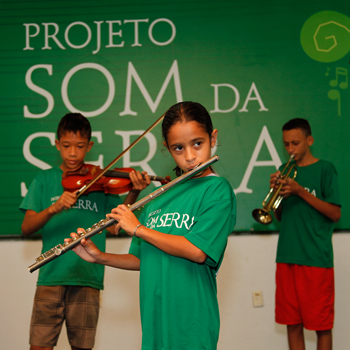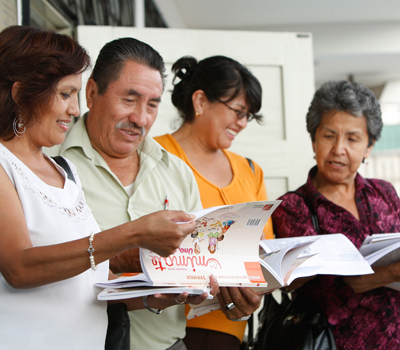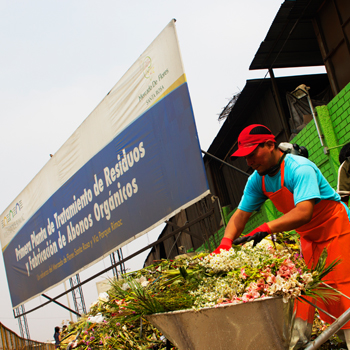Stakeholders
[GRI G4-24 G4- 25 G4-26 G4-27]Users
Aiming to strengthen relations with users, Invepar’s companies have been working on new developments aimed at these stakeholders. In 2014, MetrôRio, LAMSAC, GRU Airport and Via 040 launched applications for mobile devices, such as cell phones and tablets, designed to make users see the service not only as essential for their locomotion, but also as a mobility facilitator.
User satisfaction
User satisfaction with the services provided by the group’s companies is measured through surveys conducted by each company, the results of which are used to determine corrective or improvement initiatives.
LAMSA
Objective:
To understand Linha Amarela users’ profiles and habits, assess their knowledge and use of the services provided, as well as their opinion of the company’s management and image, and evaluate their degree of satisfaction, compared to the results of the previous year.
Methodology:
Qualitative telephone interviews with users of the emergency medical and mechanical assistance services and the automated toll-collection lanes, and in-person interviews at the toll plazas.
Sample:
401 interviews
Criteria evaluated:
Physical aspects, management and Image.
Results:

Note:
Measured on a scale of 1 to 10. Margin of error for the total sample: +/- 4.9%, with a confidence interval of 95%
CLN
Objective:
To understand Linha Amarela users’ profiles and habits, assess their knowledge and use of the services provided, as well as their opinion of the company’s management and image, and evaluate their degree of satisfaction, compared to the results of the previous year.
Methodology:
Qualitative interviews. Approximately three-quarters of the sample is approached at random at the toll plazas and asked to answer a questionnaire. The other quarter consists of users who at some point have used CLN’s services, especially the medical and mechanical services. In addition, every day the ombudsman surveys the results of users who have made use of emergency services on the highway.
Sample:
Approximately 400 interviews
Criteria evaluated:
Physical aspects, management and Image
Results:

Note:
Measured on a scale of 0 to 100.
CART
Objective:
To understand Linha Amarela users’ profiles and habits, assess their knowledge and use of the services provided, as well as their opinion of the company’s management and image, and evaluate their degree of satisfaction, compared to the results of the previous year.
Methodology:
In-person interviews on the highway and telephone interviews with users of the medical and mechanical assistance services. Application of a pre-structured and pre-tested questionnaire based on the 2013 survey
Sample:
811 in-person interviews and 100 telephone interviews
Criteria evaluated:
Physical aspects, services, service quality and Image
Results:

Note:
The scores are averages of the assessments in accordance with the grades of excellent, good, average, poor and very poor.
MetrôRio
Objective:
Monitoring the user satisfaction index.
Methodology:
In-person interviews carried out by Ibope (Brazilian Institute of Public Opinion and Statistics) through a team fully trained in how to approach groups such as MetrôRio users. The interviews are conducted in March and September of each year.
Sample:
1,001 interviewees
Criteria evaluated:
18 criteria are evaluated, including the cleanliness of the stations and trains, lighting in the cars, system security, the service provided by employees and security staff, and passenger comfort, among others.
Results:
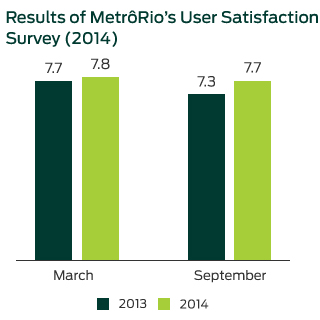
Note:
Scores are on a scale of 0 to 10. The estimated confidence interval is 95% and the estimated maximum margin of error in regard to the total results of the sample is +/- 3 percentage points
CBN
Objective:
To identify user perceptions and expectations of the roads making up the BA-093 highway system in regard to the concessionaire’s operations and construction works.
Methodology:
Quantitative survey of system users through in-person interviews and the filling out of a form. A qualitative survey is also applied to three different groups – surrounding residents, entrepreneurs and professional drivers – who take part in taped and filmed group interviews in a room equipped with a one-way mirror. Occurrences are also recorded via the company's ombudsman (ouvidoria@cbnorte.com.br), the Contact Us section of its website (http://cbnorte.com.br/faleconosco) and telephone (+ 55 71 3023 6342).
Sample:
220 interviews
Criteria evaluated:
Management, infrastructure, services, service quality and employees
Results:
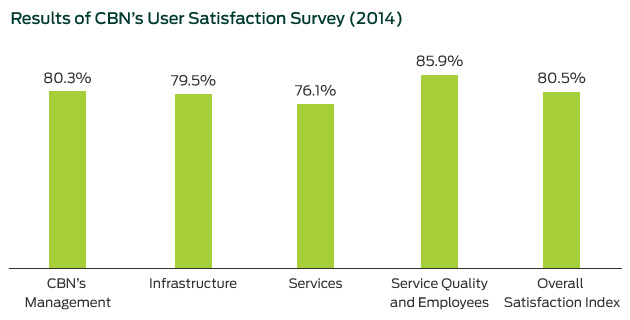
Note:
Confidence interval of 95% and margin of error of +/- 6.6%.
CRT
Objective:
To assess the level of user satisfaction with the road
Methodology:
Survey conducted by Instituto Ibope Inteligência every two years, as determined by the concession agreement. Interviews are also conducted with truck and private vehicle drivers at stop points on the stretch between Baixada Fluminense and Serra dos Órgãos.
Sample:
400 interviews
Criteria evaluated:
Condition of the highway
Results:

Note:
The company also undergoes monthly surveys conducted by the ANTT (National Ground Transportation Agency), in line with the “Standardization Draft of the User Complaints and Suggestions Report", established in October 2011 by the regulatory agency.
CRA
Objective:
To assess the level of user satisfaction regarding the road and the services provided
Methodology:
Quantitative, consisting of interviews with highway users at all toll plaza accesses for a period of five days.
Sample:
500 interviewees
Criteria evaluated:
Service quality, conservation, safety, signage and overall assessment
Results:
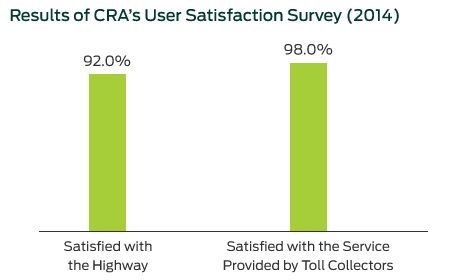
Note:
The results also identified a need for new means of providing information via the roadâs toll-free 0800 number and for paving quality improvements.
LAMSAC
Objective:
To assess the level of user satisfaction regarding the road and the services provided
Methodology:
Interviews with members of every service evaluated and an overall satisfaction study conducted every quarter throughout the length of the concession
Sample:
350 users for the service interviews and 650 users for the overall study
Criteria evaluated:
Toll services, road and automatic toll payment operations for the service interviews and overall satisfaction with the road for the overall study
Results:
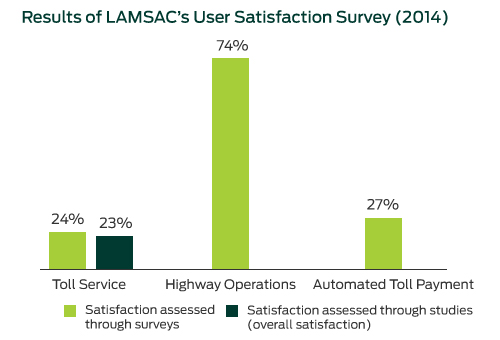
GRU Airport
Objective:
To measure overall user satisfaction with the airport
Methodology:
Monthly interviews in accordance with the methodology defined by National Civil Aviation Agency (Anac) Ordinance 3111 of November 28, 2013, thereby complying with the requirements established in the concession agreement and Anac’s regulations.
Results:
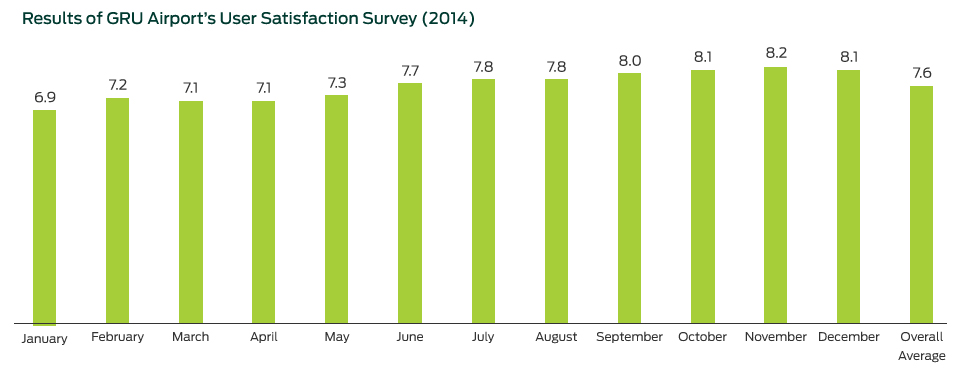
Shareholders
AInvepar's current shareholders are Previ, Funcef, Petros and OAS and their liaison with management is handled by the Corporate Governance Department. Find out more in the Corporate Governance Model section.
Employees
[GRI G4-LA16]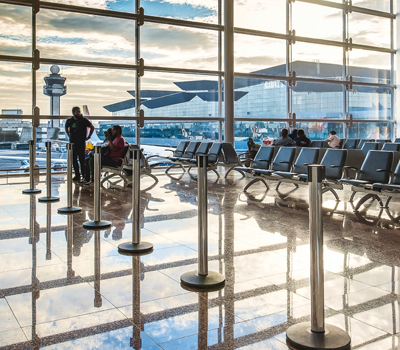
Aware of the importance of its employees in the smooth functioning of its business, the Invepar group promotes specific communication initiatives, as well as career management programs. Find out more in the People Management and Communication Plan sections.
Each group company has its own mechanisms for registering employee complaints, including, in the case of the subsidiaries, the Invepar Code of Ethics and Conduct’s ombudsman’s channel (more details in the Ethics and Transparency section). The Company also closely monitors complaints received through external mechanisms, such as the Labor Court. This monitoring plays a critical role in maintaining a good internal climate and mitigating labor liabilities.
In 2014, the group received 2,120 complaints of this type, 251, or 11.8%, of which were resolved within the reporting period.
Media
Media relations are conducted by the Corporate Communications Department, in line with the Company’s Communication Policy, which maintains its own press office team and also makes use of an external agency. Group companies also have contracts with media relations agencies or have in-house professionals focusing on the issue, responsible for conveying news, publishing press releases and information, and establishing contacts with official spokespersons. Other important sources of information include the holding’s and subsidiaries’ websites, which contain various institutional information as well as news.
In January 2015, Invepar launched another tool to further enhance its stakeholder communications. Invepar News is a biweekly newsletter which contains the most important and most recent highlights regarding the operations of the holding and the group’s 12 concessionaires in various sectors and areas. In addition to increasing the visibility of the Company's activities, the newsletter also reaffirms its commitment to transparency.
In order to receive Invepar News, simply visit the Media Center in the Press Room channel of the Company's website www.invepar.com.br and enter your name, company and e-mail address in the form provided.
Community
[GRI G4-SO1]Invepar engages with the community through its companies and their initiatives aimed at promoting dialogue and coexistence with the surrounding residents. Each concessionaire fosters, sponsors or supports a series of initiatives. For the purposes of this report, we have selected those with the greatest impact.
LAMSA
LAMSA does not currently carry out social impact evaluations, nor does it have formal stakeholder engagement plans. However, it has implemented a series of social projects with local communities, which are described below.
The company also implements the Open House project, which consists of forums with community leaders, LAMSA project coordinators and cultural producers, during which the activities developed in each community are shared and various topics are discussed to help these stakeholders develop their work. These events allow LAMSA to inform its partners of its operating policy and provide a space for discussing new and existing local demands.
Apart from Invepar’s ethics ombudsman channel, the company does not have formal mechanisms for recording community-related grievances, although the social and environmental area permits the secure and effective monitoring of this type of complaint. The communities have direct access to the company through this area and their demands are duly registered in the Social Vulnerability Matrix, which allows the company to monitor each reported grievance that requires its intervention.
All in all, LAMSA has developed 27 social and environmental projects in 21 communities adjoining the Linha Amarela involving education, sport, culture, the environment, entrepreneurship and vocational training. It is particularly worth mentioning the following four:
CLN
The company does not currently carry out social impact evaluations, nor does it participate in engagement initiatives with its adjoining community. However, it does promote social projects based on community needs that have been identified informally. These projects are described below.
Residents can record grievances or complaints regarding the company through the phone numbers (071) 3623-8020, 3623-8038 and 3623-8043 or by e-mailing the ombudsman at ouvidoria@clnorte.com.br.
CART
CART periodically maps the social networks in its surrounding municipalities (34 cities) using the indicators adopted by the IBGE (Brazilian Institute of Geography and Statistics), as well as data provided by local government. The locations impacted by the concessionaire’s works are subjected to an extra assessment through multidisciplinary meetings in which risk mitigation initiatives are evaluated and planned for execution with the support of local government and the stakeholders involved.
The results of the projects based on these assessments are periodically disclosed through social media posts, Revista Caminhos (CART’s magazine distributed to its stakeholders), local and national media and the company's website. All processes conducted with Cetesb (São Paulo State Environmental Company) are public and any person or organization may access the results or request a copy.
The company also listens to local society through a project called the Café com Ideia na Comunidade (Coffee with Ideas in the Community), where representatives of government agencies, NGOs and civil society meet to discuss issues of common interest and conduct community mobilization activities. The meetings are held in February, March, April, May, October and December.
The local community can also register requests and complaints through CART’s service center, either personally or by phone, post, e-mail or call box (emergency phones installed along the highway), which are forwarded to the ombudsman’s department, which analyzes them and informs the areas responsible for responding to the demands. The justification/response time limit is seven days. All responses are given individually via phone.
CART has also partnered with the Invepar Institute to promote certain environmental projects, which are described below.
Although the company has not yet formally mapped its stakeholders, it has informally surveyed the main ones, thereby generating input for the definition of corporate strategies. However, CART recognizes the importance of this process and aims to execute it over the next few years.
MetrôRio
MetrôRio’s social projects are aligned with the Invepar Institute’s precepts and focus on three subjects considered critical for the development and enhancement of the areas affected: education, the environment and sport and culture. Activities are based on the needs of the communities, which provide input for the drawing up of a Social and Economic Profile, which is periodically updated. In 2014, 19 social and environmental initiatives were implemented, including private social investments, incentive-related projects and the provision of institutional support for projects, programs and actions in 25 communities adjoining Lines 1 and 2, including the four listed below.
MetrôRio also seeks to reinforce its activities and its commitment to the communities through direct relationship initiatives, such as the Community Network, the Volunteer Program, Estação Alegria (Happiness Station) and the Beginning Careers Program. The goal is to strengthen local development and increase dialogue.
The company also maintains an internal Corporate Social Responsibility Committee, comprising representatives from different areas, which discusses social responsibility policies, guidelines and initiatives.
Currently, there are no formal procedures for handling community complaints. However, the company does receive a large volume of requests through its service channels, ranging from asking for information on the operational system or requesting support or solutions related to occurrences reported by users or local residents. MetrôRio has five such channels: suggestion boxes, call center, customer area, Contact Us and correspondence (conventional or e-mail).
CBN
CBN compiles a survey of its neighboring communities’ welfare conditions composed of information from residents and community leaders. It also identifies possible social impacts by holding regular meetings and providing communication channels, and implements solutions to mitigate them. In addition, it records the coverage of its social initiatives by gender, reporting the numbers of men and women who are influenced directly and indirectly.
There is no structured plan for stakeholder engagement. However, every year CBN executes the Café com Responsa (Coffee with Responsibility) project, which addresses Corporate Social Responsibility with the company’s key stakeholders. The results of these initiatives are disclosed directly to those involved and through large, medium and small circulation publications to the general public.
Nine environmental projects were developed by CBN in 2014, including the five listed below:
CRT
CRT does not conduct environmental impact assessments or develop engagement initiatives with its surrounding communities. However, it does implement social and environmental projects for these communities. In 2014, six projects were developed by the company, including the four below:
CRA
CRA believes that its main social impact comes from exempting its local community residents from the road toll so they can fulfill their daily transport needs.
The concessionaire maintains constant dialogue with its adjoining community, either through the environmental initiatives described below, or through informative meetings with residents and their representative committee. The Mercês Community committee, considered vulnerable, was assembled with the help of CRA. Complaints and grievances can be reported at these meetings or through the company's ombudsman.
The results of the social and environmental initiatives are disclosed through e-mail, posters on walls, social media, the company's website and in-house magazine, partner companies’ means of communication and monthly reports to the granting authority.
CRA has developed four social and environmental projects/programs in at least five communities of the two cities in which it operates, including the four listed below.
LAMSAC
LAMSAC’s social strategy is based on a series of activities and projects in its surroundings with two major objectives: in the short term, the resettlement of the population affected by the route and, in the long term, the consolidation of appropriate relations with the neighboring communities, mitigating any potential social risk.
In this context, in 2011 we initiated LAMSAC’s Citizen Participation process, which was responsible for the Environmental Impact Study. Sixteen exploratory meetings were held in the concession’s area of influence to gauge community needs, together with 14 informative workshops and two public hearings, resulting in the drawing up of environmental management strategies, including the Community Relations Plan, the Compensation and Area Clearance Program and a program to monitor and control the initiatives implemented. It is worth noting that, since 2010, LAMSAC has maintained a permanent service center for those settled at the beginning of the concession, facilitating the receipt of complaints and questions from stakeholders, which can also be sent by e-mail or via the company’s website. The community can also voice their grievances through LAMSAC’s customer service channel, in person or by e-mail.
As a social management tool, LAMSAC also maintains a Geographic Information System, which contains a registry of up-to-date information on the company's area of influence and provides technical input for decision making. In 2014, LAMSAC implemented 11 environmental projects in 32 communities, including the following four.
ViaRio
ViaRio has conducted a survey of the population at social and environmental risk in the areas affected by the expropriation, the results of which can be found on the supervisory body’s official website (www.inea.rj.gov.br), as well as a socio-political study of the area through which ViaRio passes, allowing the mapping of local community vocations, which is currently under way.
GRU Airport
GRU Airport does not yet undertake social impact evaluations. However, when the company took over management in 2012, it conducted a socio-territorial study of Guarulhos, where the project is located, in order to determine the size of the area impacted by airport activities and compile a social and economic portrait of the city, the results of which formed the basis of the company’s social projects, as described below.
Social dialogue and community relations are conducted by the Social Responsibility department through visits to neighborhood associations and social entities in the surrounding communities in order to resolve doubts concerning the changes implemented after the concession was granted and the development of projects for the company’s Social and Environmental Project Selection Notice, as well as environmental and safety issues. In addition, three times a week a company social worker visits the Malvinas community, which borders the facility’s installations and access road, in order to open a channel so that the issues raised by the residents are directed to and managed by the appropriate area, or are mediated with municipal government agencies.
Grievances and complaints and are addressed through the ombudsman or a specific e-mail address and are dealt with by Social Responsibility department. Feedback is given within seven days.
GRU Airport’s main environmental projects in 2014 are listed below:
Via 040
Between May and August 2014, with the support of the Invepar Institute, Via 040 conducted a social and economic diagnosis of the 35 municipalities intercepted by the project in order to map and describe the current situation of the right-of-way occupations.
Through development and the implementation of social and economic research, it was possible to identify the social relations of the various groups occupying the roadside and the main points of interest along the stretch. This diagnosis is directly related to the Social Management Plan requested by the Highway Exploration Plan and will provide the guidelines for evacuating/expropriating the right of way.
In regard to the expropriations, since October 2014 the company has been receiving the direct assistance of a Federal University of Minas Gerais professor and PhD, who has been working with the community in the municipality of Caetanópolis (MG) for more than ten years, culminating in her doctoral thesis "Adaptive management of minhocuçu (Rhinodrilus alatus)". This city has a traditional community whose economic base is installed along the margins of the BR-040 highway. The aim of the relationship is take advantage of the professor’s knowledge to ensure a more assertive and targeted approach in regard to the locals since the minhocuçu trade stalls will be relocated due to the project. Rhinodrilus alatus is a type of giant earthworm, much sought after as fishing bait.
Suppliers
[GRI G4-12 G4-DMA Procurement practices G4-EC9 G4-EN33 G4-LA15]With 12 companies located in different regions, the Invepar group has a vast supply chain, comprising 6,862 suppliers, which received total payments of around R$2.5 billion in 2014 and are estimated to have acquired inputs or services from at least another 47,921 companies.
In order to ensure that suppliers act in accordance with its ethical, labor and environmental principles, Invepar adopted a Procurement and Contracting Policy, which establishes the model to be used by companies when acquiring their inputs and contracting services, among others. All group companies are subject to this policy.
The document states that prioritizing local suppliers is not a primary consideration, but one that should be analyzed and considered. However, most subsidiaries, whether wholly-owned or not, opt for companies that are located nearby, thereby contributing to the development of their surrounding regions. In 2014, expenditures with local suppliers totaled R$468.36 million.
One hundred and five suppliers of CLN, CART, CBN, CRT, CRA and LAMSAC were subject to environmental assessments in 2014, which are currently the only group companies to formally implement this practice. Of this total, 19 were identified as causing actual or potential adverse environmental impacts. In addition, LAMSA, despite not conducting official evaluations, identified 11 suppliers with some adverse impacts. Of these 30 (equivalent to 10%), only CART reached an agreement with three of its suppliers to ensure improvements. None of the other companies ended relationships with suppliers in this situation.
In the case of good labor practices, 556 suppliers were subject to evaluation. Only CLN, CART and GRU Airport have formal evaluation processes. The other companies, despite not having official supplier assessment procedures, have contracts that require compliance with legal requirements. Twenty-three companies were identified as causing significant real or potential adverse impacts in relation to labor practices. Of these, six had their contracts terminated, all off which part of GRU Airport’s supply chain, equivalent to 26.1% of total suppliers with identified impacts. The Company assesses the risk of maintaining suppliers who do not comply with their obligations related to good labor practices and/or do not have the minimum documentation required by the contract. In the case of continuous labor-intensive services, GRU’s contracts contain a clause permitting unilateral termination without cause upon 30 days’ notice. Should analyses conclude that maintaining relations with these companies represents an unacceptable risk, this clause is activated.

Projeto Decolando com Guarulhos (Taking Off with Guarulhos Project)
In 2012, based on a socio-territorial study conducted in association with Sebrae (Brazilian Micro and Small Business Support Service), GRU Airport created the Taking Off with Guarulhos project, which is aimed at encouraging the formalization of entrepreneurs and the strengthening of micro and small businesses in the municipality of Guarulhos and the airport’s surrounding regions. The idea is to create a favorable environment for the development and strengthening of the local economy by stimulating existing vocations and activities. Before the concession, only 1% of purchase volume came from local businesses, given that there was no solid and recognized supplier base in the region to involve in the procurement process, in turn due to the previous operator’s public bid contracting model which imposed restrictions on the prioritization and development of local suppliers.
Since the beginning of the project 161 micro and small businesses have participated on two fronts:
Territorial Development – Focuses on the identification and development of local entrepreneurs and improving business management through training programs conducted by Sebrae. In 2014, 55 micro businesses participated in these activities, 16 of which received the Taking Off with Guarulhos award after presenting business improvement projects. GRU Airport contributed a total of R$150,000, which will be invested in projects developed by the participants, in accordance with the approved budget for each project.
Development of Production Chain -Aims to identify and develop local suppliers with the potential to meet GRU Airport's demand for goods and services. In 2014, 106 companies participated in Sebrae training programs.
Government
Municipal, state and federal government bodies, as well as regulatory agencies, are among Invepar’s main stakeholders, giving that they constitute the granting authority, which the Company depends directly on for expanding and/or improving its business. Liaison with these stakeholders is handled by the Institutional Relations area.
Financial assistance received from the government
[GRI G4-EC4]Of the Invepar group companies, CRA, CBN, CLN, CART and MetrôRio receive tax benefits, which are granted indiscriminately to all companies who meet the conditions determined by the prevailing legislation. They are not individual in nature and do not involve Invepar group companies only.
CRA, CBN and CART benefited from the Reidi (Infrastructure Development Incentive Regime), which suspends the levying of PIS/COFINS taxes on the acquisition or importation of new machinery, appliances, instruments and equipment, as well as building materials to be used in or incorporated by infrastructure works to be recognized under property, plant and equipment by duly authorized companies. In 2014, these benefits totaled R$15,046,135.03 for CART, R$3,857.00 for CBN and R$839,467.00 for CRA.
In regard to the Brazilian subway segment, MetrôRio benefited from a change in Federal Law 12860/2013, resulting from the conversion of Provisional Presidential Decree 617/2013, which exempted PIS and COFINS taxes on revenue from the provision of regular municipal public transport services involving the transportation of passengers by road, subway, rail and water, generating R$25,243,400.00 in 2014. It is worth noting that this benefit was used as partial compensation for the tariff freeze in 2013, as stipulated in the concession agreement.
The remaining benefits, totaling R$5,569,800.00, came from Law 12546/2014, which replaced the employer’s payroll tax rate of 20% with a tax of 2% of gross revenue.

